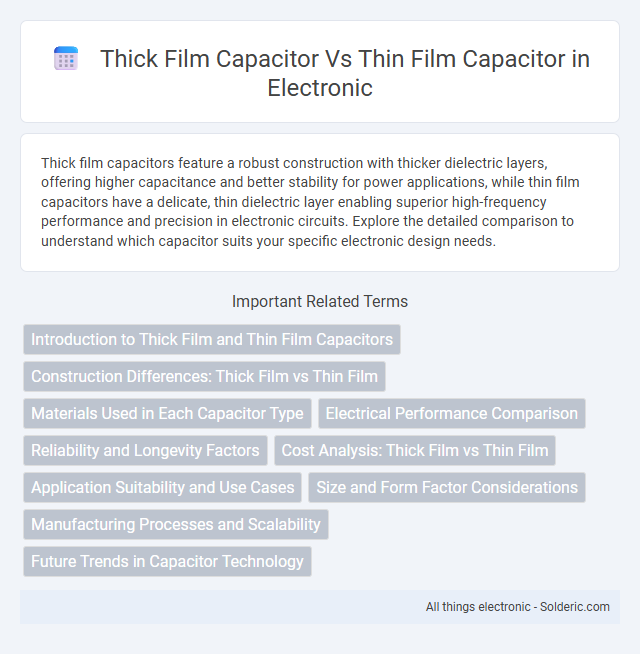Thick film capacitors feature a robust construction with thicker dielectric layers, offering higher capacitance and better stability for power applications, while thin film capacitors have a delicate, thin dielectric layer enabling superior high-frequency performance and precision in electronic circuits. Explore the detailed comparison to understand which capacitor suits your specific electronic design needs.
Comparison Table
| Feature | Thick Film Capacitor | Thin Film Capacitor |
|---|---|---|
| Dielectric Material | Thick ceramic or polymer layer | Thin ceramic or polymer layer |
| Capacitance Range | High, typically microfarads to millifarads | Lower, typically picofarads to microfarads |
| Size | Larger due to thick dielectric | Smaller, compact design |
| Frequency Response | Lower frequency applications | High frequency, RF applications |
| Voltage Rating | High voltage tolerance | Lower voltage tolerance |
| Temperature Stability | Moderate stability | High stability and precision |
| Cost | Lower cost, mass production | Higher cost, precision manufacturing |
| Applications | Power supplies, smoothing, decoupling | High-frequency circuits, filters, oscillators |
Introduction to Thick Film and Thin Film Capacitors
Thick film capacitors utilize a ceramic substrate coated with a thick layer of conductive material, offering high capacitance values and robust performance in high-voltage applications. Thin film capacitors feature a vapor-deposited thin layer of metal on an insulating substrate, providing superior precision, low loss, and excellent stability for high-frequency circuits. These fundamental differences influence their selection based on required capacitance, reliability, and frequency response in electronics design.
Construction Differences: Thick Film vs Thin Film
Thick film capacitors feature a dielectric layer formed by screen-printing conductive paste onto a ceramic substrate, resulting in a relatively thicker dielectric layer typically in the micrometer range, while thin film capacitors utilize vapor deposition techniques to create ultra-thin dielectric layers often in the nanometer scale. The construction of thick film capacitors involves multiple printed layers stacked to achieve desired capacitance, leading to higher loss and lower precision compared to thin film capacitors, which have tightly controlled layer thicknesses for superior performance and stability. Thin film capacitors generally offer higher frequency response and lower equivalent series resistance (ESR) due to their uniform, precisely engineered dielectric and electrode layers.
Materials Used in Each Capacitor Type
Thick film capacitors typically use ceramic or polymer-based dielectric materials combined with conductive paste for their electrodes, offering robust performance at a lower cost. Thin film capacitors employ metal oxides or high-purity dielectric layers deposited through sputtering or chemical vapor deposition on substrates like silicon or glass, resulting in superior precision and stability. Your choice depends on whether you prioritize cost-efficiency with thick film materials or high reliability and exacting specifications with thin film technologies.
Electrical Performance Comparison
Thick film capacitors generally offer higher capacitance values and better surge current handling due to their robust ceramic dielectric layers, making them suitable for power electronics and filtering applications. Thin film capacitors provide superior electrical performance with lower equivalent series resistance (ESR) and inductance, resulting in higher frequency response and stability for precision circuits. The choice depends on the specific requirements of capacitance, frequency tolerance, and reliability within the electrical system.
Reliability and Longevity Factors
Thick film capacitors exhibit higher mechanical robustness and better tolerance to environmental stress, contributing to enhanced reliability in harsh conditions. Thin film capacitors, however, offer superior electrical stability and lower dielectric losses, which extend operational longevity in high-frequency applications. Both technologies balance trade-offs between durability and performance based on the dielectric materials and fabrication processes used.
Cost Analysis: Thick Film vs Thin Film
Thick film capacitors generally offer a lower cost per unit compared to thin film capacitors due to simpler manufacturing processes and less expensive materials. Thin film capacitors provide enhanced performance, such as higher precision and stability, but come at a premium price because of their complex fabrication techniques involving vacuum deposition. Your choice depends on balancing budget constraints against the required electrical characteristics for the specific application.
Application Suitability and Use Cases
Thick film capacitors are ideal for high-voltage applications and power electronics due to their robust construction and ability to handle high energy levels, making them suitable for automotive and industrial equipment. Thin film capacitors offer superior precision and stability, favored in high-frequency circuits and sensitive electronic devices like RF communication systems and medical instruments. Your choice depends on whether durability and voltage handling or precision and miniaturization are more critical for your specific application needs.
Size and Form Factor Considerations
Thick film capacitors typically offer larger size and higher capacitance but may occupy more space compared to thin film capacitors, which are known for their compact form factor and precise thickness control. Thin film capacitors allow for smaller, more uniform dimensions, making them ideal for applications requiring miniaturization and high-frequency performance. Your choice depends on space constraints and the specific electrical characteristics needed for the device.
Manufacturing Processes and Scalability
Thick film capacitors are manufactured using screen printing techniques to deposit a paste of conductive and dielectric materials onto a ceramic substrate, enabling cost-effective mass production and high scalability. Thin film capacitors rely on vacuum deposition methods, such as sputtering or chemical vapor deposition (CVD), to create uniform, ultra-thin dielectric layers with superior precision but limited scalability due to higher manufacturing complexity and equipment costs. Your choice between these capacitor types depends on the balance between performance requirements and production volume constraints.
Future Trends in Capacitor Technology
Thick film capacitors are evolving with enhanced energy density and thermal stability, catering to high-power applications, while thin film capacitors lead in miniaturization and high-frequency performance essential for advanced electronics. Emerging trends emphasize integrating nanomaterials and flexible substrates, pushing capacitors toward greater efficiency, reliability, and adaptability in IoT and wearable devices. Your choice between thick and thin film capacitors will increasingly depend on the specific demands for size, frequency response, and environmental resilience in future technology landscapes.
thick film capacitor vs thin film capacitor Infographic

 solderic.com
solderic.com